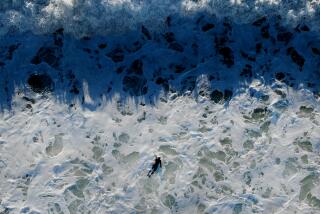Surfing Cradle Created a Giant : Hobie Alterâs Balsa Boards of Yesteryear Launched Great Wave in Water Sports
DANA POINT â Whizzing along Coast Highway, it is easy to overlook the tiny Hobie sport shop in the old part of town.
Tucked unassumingly between a large real estate office and a residential program for alcoholics and drug abusers, the modest gray shop has peeling trim and stucco walls in the style of the 1950s. Its windows are lined with the usual assortment of wet suits and other surfing paraphernalia. And inside, an array of shiny surfboards hangs on the walls.
A discerning look at those walls, however, reveals something beyond the ordinary. Two of the boards hanging there are genuine antique Hobies, fashioned entirely of balsa in the mid-1950s. And a small sign informs the curious observer that both were handcrafted by the master himself--Hobie Alter--right here in this shop.
In fact, says Jack Cantu, who has worked for the Hobie company since the 1960s, this is where the modern surfing industry really began.
From this modest shop in Dana Point, Alter parlayed an inventive mind and skill at shaping surfboards into a multimillion-dollar water-sports empire that, in addition to revolutionizing surfing and making him famous, eventually gave the world a better catamaran in the form of the Hobie Cat. His name now adorns an international line of products, ranging from sunglasses to beachwear.
âHobie is the Henry Ford of surfing,â says Griff Snyder, curator of the Huntington Beach International Surfing Museum and an expert on the sportâs history. âHe was one of the first to mass produce surfboards.â
Cantu says: âWhen it comes to surfing, Hobie is king. All he wanted to do was make toys for himself, and they just turned out to be popular.â
Alter, now 58, began making those âtoysâ as a teen-ager in 1950. A resident of Ontario, he spent the summers of his youth at a house owned by his family on the sand in Laguna Beach. It was there, he says, that he first tried surfing and, during the summer he was 16, learned from a friend how to make himself a balsa surfboard.
âI sold my own board twice,â Alter recalled during a recent interview, reflecting an entrepreneurial spirit that was eventually to make him one of the first surfing millionaires. To fill the orders and keep surfing himself, he built two more boards, letting them go for $65 apiece--a profit of $25.
âNobody had ever before given me more money for something than it had cost me to make it,â he says. âI thought that was pretty keen.â
For the next several years, the young Alter manufactured about 20 boards each summer in the garage of the Laguna Beach house, earning enough money to keep himself surfing instead of working as a lifeguard.
Then, in 1954, he graduated from junior college and needed a job. At the suggestion of his father, Alter spent an $8,000 inheritance to buy a lot on Coast Highway in Dana Point and build the cityâs first surf shop.
âIf the surfboard thing didnât work out, I figured I could put a cabinet shop in there,â Alter recalls.
The surfboard thing did work out. Located right on the highway, the shop didnât even have to advertise. From virtually the moment it opened, Alter says, he was booked up with a six-week waiting list for boards.
Eventually the master surfboard maker hired others to do some of the work and invented machines to perform parts of the process.
Then, in 1959, he came up with an innovation that was to revolutionize the sport. Instead of using the increasingly rare and expensive balsa, Hobie began making boards out of polyurethane foam, a durable synthetic material that lowered the cost and sped up the process.
While Alter was not the first to use the material, he was the first to mass-produce the foam boards, paving the way for the surfing craze that was to follow in the 1960s and creating the prototype still in use today.
âIt set the standard,â Alter says. âWithin a year, virtually everyone was making foam boards.â
With the increased profits from the new product, the rising entrepreneur was able to embark on his next major endeavor: giving the world a better catamaran. By the mid-1960s, Alter had developed a serious interest in sailing and owned an 18-foot catamaran weighing 600 pounds.
There was only one problem: It took too many people to lift and was designed to be launched from a trailer. âWeâd have a beer,â Alter recalls, âand say, gee, if we just had a little boat that could go through the surf. I thought it would be fun to try.â
One year and many dollars later, enter the Hobie Cat, the first catamaran light and maneuverable enough for one person to launch from the beach and sail out through the surf. Within a few years, the new boat had become one of the most popular crafts in the world, virtually changing the standards by which catamarans are judged. To date, Alter says, more than 150,000 have been sold.
âHeâs had a substantial impact on boating,â says Snyder, who is also a sailing enthusiast. âAn awful lot of people have learned to sail on Hobie Cats.â
His place in water-sports history assured, Alter was able to turn his attention to ever more profitable endeavors. He produced skateboards for a time in the 1970s. Later, he lent his name to a chain of retail stores, including 10 outlets in California and Hawaii, as well as a line of beachwear, womenâs bathing suits and sunglasses.
Three years ago, Alter retired and moved to an island north of Seattle, where he now spends much of his time cruising about in a 60-foot motor-powered catamaran of his own design.
While the surfboards and boats continue to be manufactured and sold, Alter no longer has a financial interest in them. His 30-year-old son, Jeff, now serves as president of Hobie Designs Inc., based in San Clemente, which functions primarily as a licensing agency for the Hobie name.
And Hobie himself, sad to say, doesnât even own a Hobie Cat anymore. âWhen you have something like that,â he says, âyou have to take care of it. Iâm afraid all my boats have motors in them now.â
He does still own a tangible piece of real estate from his own unbelievable past, however; the little building in Dana Point where it all started 38 years ago.
Things are a lot quieter there now. Business has been slow for some time, sparking concerns about how much longer the tiny shop can survive. Yet there is an unmistakable air of pride among the shopâs employees and some customers.
âThereâs a lot of history here,â says Bill Parks, the storeâs manager. âIâd like to keep it alive.â
Says Robert Foster, 31, a regular customer: âThe other Hobie shop(s) are pretend. This is the real one.â






